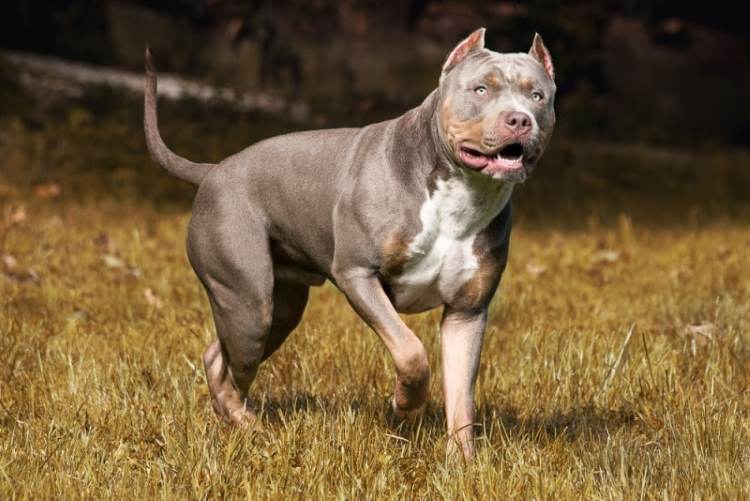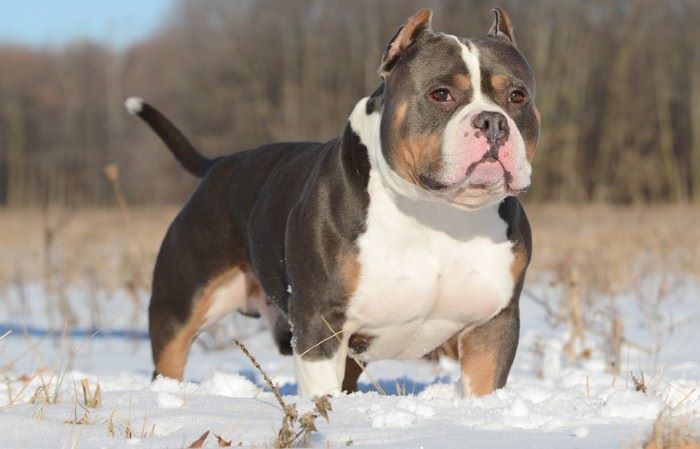The tri color bully is a popular American breed that has wonderful coats in different hues ranging from chocolate, lilac, black, and blue (base colors). It is a matter of curiosity for dog lovers to know more about the tri-colored bully. What is exactly a tri-colored bully breed? Specifically, the coats of the bullies have magnificent soothing three colors instead of stray tan points.
Or maybe, there is a . single base color along with tan points to design the fur coat of this type of American breed. Due to the fusion of different breeds or dilution, the most prominent merle or piebald color can remove or fade the base colors. There will be different color shades like trundle, ghost tan, and tri merle.
What Is Tri Color Bully?
The tri colored bully is a famous American breed that has multiple base colors combined with tan points. Often due to gene intensity expression or mutation, the pigments of hair strands of the coat of the tri color bully can receive changes. There are irregular patches of white and black colors that cover the dog’s coat.
What Are Causes of Tri-color Coat Pattern of Bully?
Bully breeds have regular tricolor patches. However, often these colors are subject to modification due to genetic disorders, mutation, and intensity gene expression. Pigments are essences of tri colors. The coat color of the dog depends on two pigments to form the original base colors of the bully. Every pigment has a pre-configured base color which can be altered or affected due to gene-related issues. Usually, a bully dog has two pigments forming red and black colors. After studies, experts have confirmed the intervention of the tan points gene to create tri-colors of the bully breed.
The Originality of Tri-color Gene in the American Bully Breed
While finding the originality of the tri color bully of the American bully, experts discovered interesting facts connected with the tri-color genetic evolution. In the early stage of cross-breeding, American pit bull terriers got back tan points through genetic evolution. Fox terriers and bulldogs were cross-bred in the 19th century to have the new American pit bull terriers with original tan points to form the tri-colors.
The extensive research further proves that crossbred fox terrier is believed to have possessed tan point allele from black terriers with tan points. Later, through evolution, this allele took a switchover passing from pit bull terrier to another new breed called Staffordshire terrier and the American bully after cross-breeding.
How Does Tri-color Bully Behave?

In most cases, it is found that the bully tri color is modest with a cool attitude. American tri-color bullies are sportive and funny to play with children. However, due to cross-breeding, tri color bully are carriers of genetic features of the American Staffordshire Terrier and American Pit Bull Terrier. In other words, the loyalty and dedication of American pit bulls are combined with the sociability of the Staffordshire breed.
These two traits are available in new cross-bred dogs with tri-color coats. Often, American tri color bully becomes arrogant and rude to treat humans roughly. This excellent tri color bully is playful and jolly to befriend others as well. If they are trained, they become sociable, modest, and cute to live with other representatives of society.
What Is the Determinant for Making Bully Rare?
Since the inception of American tri color bully, experts did not find any health issues after the complete cross-breeding. So, it is not the reason behind the reluctance of breeders to cross-breed such tri-color animals. According to them, professional dog breeding specialists do not prefer tri color bully with tan points. Buyers like the original breeds without signs of cross-breeding. They mix the tri-colored dogs with other species. That’s why; breeders do not show much interest in producing tri-color breeds frequently.
What Are Uncommon Features of the Tri-color Bully Rare Breed?
Tri color American bully is rare and uncommon. If parents of this breed produce offspring, they can’t guarantee the production of the tri-colored species. Or, their coats are not tri-colored, though they have tan points recessive genes. Their poodles are carriers of tan points of parents. If they have traditional tan points, the possibility of visibility of tri-color is high. In case a single puppy has a dominant black gene, there is least chance of display of white color on the coat of the newborn puppy.
Different Sizes of Tri-color Bullies?
American tri-color bullies are found in various sizes depending on the cross-breeding and health of the parents. Experts measure their sizes to select the crossbreeds for raising. Have a look at the few examples below to know about the possible sizes of tri-color bullies.
| Size | Weight | Bully Height |
| XL Bully | 85+ pounds | 20-23 inches |
| Standard Bully | 60-85 pounds | 17-20 inches |
| Classic Bully | 50-70 pounds | 17-20 inches |
| Pocket Bully | 20-25 pounds | 14-17 inches |
Various Types of Tri Color Bullies
Tri-color bullies are innovative, jovial, and sportive. They are healthy crossbreeds that have multiple base colors with tan points. While selecting the best bully for raising, you need to know about the varieties of this breed.
Micro/ Exotic Bully
Micro means portable or miniature. Therefore, these small bullies look like portable handsets. The pocket-size dogs are crossbred with Patterdale Terrier resembling the local pocket bully. The minus point is that these tiny bullies have health hazards that obstruct their growth. They need proper medical care and nutrition to stand firmly on the ground.
Extreme Bully
Compared to typical cross-bred dogs, the extreme bully has strong musculature with sturdy shoulder, head, and limbs. Therefore, they have the ability to live in adverse weather.
Double XL Bully
Double XL or XXL bully is oversize, measuring 23 inches max. This lengthy serpentine body is a threat to others. However, this typical breed faces frequent health issues. The front and rear legs of the dog are under pressure from the heavy weight of the body. Therefore, the lifespan of this breed is short.
Conditions of Producing Tri-color Bully
Tri-color bully is not found everywhere. Certain circumstances influence the breeding process to produce the tri-color bully. Through the blend of two tri-color parents, a true tri-color bully puppy is born. However, if one breed is tri-color and another tri-carriers, the chance of production of a tri-color puppy is 50/50. Though the tri-color cross-bred dogs have three colors, there are specific conditions. The coat color of parents passes to the offspring through cross-breeding.
The parents have often different base colors ranging from lilac, and blue, to chocolate. Often, the base colors are not properly expressed or exhibited due to the dilution or genetic intensity expression. This genetic trait is obviously visible in the offspring of the parents. This color variation occurs due to such biological mutation or gene intensity expression.
Is a Tri-color Bully a Separate Coss-Breed?

Many critics confuse people. They opine that tri-color bully is a separate breed. It is not exactly as they think. Due to the color variation, perhaps, people are misguided. They take it as a separate cross-bred bully through the reproduction process. However, few experts claim that the American bully with tri-color is mixed with another terrier breed to have a different offspring. It is not a fact that these newly bred dogs will have full-scale visible tri-colors. Due to the different genetic traits, maybe, the cross-bred dogs have separate behavioral patterns.
In reality, original tri-color bully breeds are not separate entities but they belong to the same class. By training these new breeds, you can reset and fix the behavioral patterns of the dogs. They respond to the orders of their masters. Their sportiveness is prominently visible and palpable. They are fond of human associations.
Eligibility Criteria for Being A Tri-color Bully
For being a tri-color bully, a dog should have certain genetic traits to become eligible and competent. They have tan points in both parents or they are homozygous. Besides tan points, the new cross-bred pups should have base colors like lilac and white.
Conclusion
It is the recessive gene that plays behind the creation of tri-color bullies. It is also called the tan points gene. The color variation of the tri-color bully breed is influenced by gene intensity expression and dilution. However, if you are experienced with expertise in gene expression and mutation for cross-breeding, you can take tri-color bullies for cross-breeding. You should opt for strong and healthy breeds for producing another new pup having the tri-colors with the same genetic traits.
FAQ
Q: What is cross breeding?
A: By cross breeding, you will produce the separate breed with combined features of parents. Mix one breed with another class breed to produce the new cross bred pup.
Q: Is American tri-color bully healthy?
A: After cross breeding, the tri color bully has no severe health hazard.
Q: What is base color of American tri color Bully ?
A: The base color can be white and lilac.
Read More: All about Grain Free Dog Food with the Analysis of Pros and Cons

